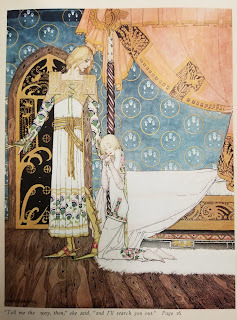 Even though many people today see fairy tales as nursery stories, folklore has a surprising and somewhat uncanny way of proving itself relevant and pervasive in human society. The titular story of this collection, “East of the Sun and West of the Moon,” is a Scandinavian fairy tale about a young girl who agrees to live in an enchanted castle with a talking white bear so that her poor family may become rich. Every night, a mysterious stranger comes and sleeps on the other side of the young woman’s bed, though she never sees who it is. Eventually, the young woman visits her family, and is persuaded to smuggle a candle back with her, so she can catch a glimpse of the person who shares her bed each night. When she does, she discovers that he is an incredibly handsome prince, but accidentally drips candle wax on him and wakes him. He laments that if she had held only out a year, he would have been free from the spell that trapped him as a white bear, but now he is instead doomed to be taken to live with his wicked stepmother, who is, incidentally, a troll. He can only tell the young woman that his troll stepmother is taking him to a place east of the sun, and west of the moon, before he and the enchanted castle are gone. Following this impossible clue, our young heroine undergoes a lengthy journey and multiple trials only to find him about to be married to the troll princess. Through some clever trickery, the young woman manages to meet alone with the prince, and together they devise some more clever trickery involving competitive laundry to free the prince from the trolls’ clutches, and allow him to marry our heroine. All the trolls are so angry that they explode, and everyone else lives happily ever after.
Even though many people today see fairy tales as nursery stories, folklore has a surprising and somewhat uncanny way of proving itself relevant and pervasive in human society. The titular story of this collection, “East of the Sun and West of the Moon,” is a Scandinavian fairy tale about a young girl who agrees to live in an enchanted castle with a talking white bear so that her poor family may become rich. Every night, a mysterious stranger comes and sleeps on the other side of the young woman’s bed, though she never sees who it is. Eventually, the young woman visits her family, and is persuaded to smuggle a candle back with her, so she can catch a glimpse of the person who shares her bed each night. When she does, she discovers that he is an incredibly handsome prince, but accidentally drips candle wax on him and wakes him. He laments that if she had held only out a year, he would have been free from the spell that trapped him as a white bear, but now he is instead doomed to be taken to live with his wicked stepmother, who is, incidentally, a troll. He can only tell the young woman that his troll stepmother is taking him to a place east of the sun, and west of the moon, before he and the enchanted castle are gone. Following this impossible clue, our young heroine undergoes a lengthy journey and multiple trials only to find him about to be married to the troll princess. Through some clever trickery, the young woman manages to meet alone with the prince, and together they devise some more clever trickery involving competitive laundry to free the prince from the trolls’ clutches, and allow him to marry our heroine. All the trolls are so angry that they explode, and everyone else lives happily ever after.But wait! This sounds oddly familiar…at first you were probably thinking “Beauty and the Beast.” Towards the end, though, you may have shifted more towards Greek mythology, and thought “Cupid and Psyche.” Indeed, “East of the Sun and West of the Moon” is remarkably like both stories, even though all three come from distinct cultures and periods of history. Finding common elements in fairy tales, or even almost identical fairy tales, in wildly distinct parts of the world is actually pretty common; some form of the story “Cinderella” has appeared in hundreds of variations around the world! Whether the universality of some of these stories hints at international trading of folklore and mythology, allowing these tales to travel globally as different societies intersect, or of some deeper insight these stories provide into the human experience that prompts them to arise out of cultures on different sides of the world, fairy tales seem to offer a depth of possibility worth exploring long after we leave the nursery.
Kay Nielsen’s stunningly illustrated East of the Sun and West of the Moon: Old Tales from the North, includes both this tale and other Scandinavian folk stories (many featuring trolls). Nielsen’s artwork lends an even more haunting feel to the fairy tales, evoking the stark yet unearthly beauty of the Scandinavian landscape. Whether these somewhat obscure northern stories resonate with the folklore you are familiar with or not, you may find something unexpectedly fun, fascinating, or profound within these pages. At the very least, you’ll be able to enjoy Nielsen’s striking illustrations! To see the book, come in and ask for Rauner Illus N554a.


No comments:
Post a Comment